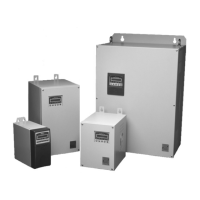MSC-3 Instruction Manual
Glossary
~STOP The logical inverse of STOP. This circuit must be closed for the MSC-3 to run.
2-wire control Control of the stop / start function by a simple contact closure (eg a start / run
switch contact).
3-wire control Control of the stop / start function by momentary contacts, typically separate
start and stop pushbuttons. This arrangement has the advantage of preventing
an inadvertent re-start following a power outage.
COM The common terminal to which all inputs on the MSC-3 are referenced.
AWG American Wire Gauge
Console The pushbuttons and LCD display on the front of the MSC-3
Constant Torque A load characteristic in which the driving torque requirement is largely
independent of speed. e.g. a horizontal conveyor
DC Bus Choke An inductor connected in series with the DC bus inside the MSC-3. This
provides several benets including reducing the harmonic content of the AC line
current.
EMC Electromagnetic Compatibility. The arrangement of emission and immunity
levels to achieve functional coexistence between various items of equipment in
a given environment.
EN The enable input on the MSC-3.
ESO Essential Services Override. A mode of operation that disables certain
protection features in order to allow the MSC-3 and/or the motor to run to
destruction in certain circumstances, for example clearing smoke from a
building.
HVAC Heating, Ventilation and Air Conditioning [industry]
IEC International Electrotechnical Commission, publisher of many standards related
to electrical / electronics technology.
IN+, IN- These are the designations of differential analog inputs on the MSC-3. The
MSC-3 will respond to the difference between the two inputs, rather than the
voltage between either input and AN COM.
JOG A control input that causes motion only while it is active (ie non-latched) that is
usually used to manually operate equipment for the purposes of setting up or
alignment prior to continuous operation.
LATCH A feature of a control input that requires only a momentary signal (e.g. contact
closure) to provide sustained (latched) operation.
Local Operation of the MSC-3 from the console pushbuttons on the enclosure.
NEMA [The American] National Electrical Manufacturer’s Association, publishers of
various NEMA standards.
PF Power factor. The ratio of real (active or in-phase) current to the total current in
an AC circuit.
PID A type of automatic controller that seeks to drive a measured value (e.g.
temperature, pressure etc) to a preset value by means of a control effort (e.g.
motor speed) determined by proportional, integral, and derivative functions.
PID, reverse acting A PID control system in which an increase in control effort (e.g. motor speed)
results in a decrease in the measures variable (e.g. temperature). A common
example is a cooling tower where an increase in fan speed causes a reduction
in water temperature.
Ramp A control function within the MSC-3 that controls the rate at which the motor
speed can increase or decrease.
Remote Operation of the MSC-3 via connections made to the control board terminal
strip.
RMS Technically, Root-Mean-Square. A method of measuring an AC voltage or
current that gives the same numerical result as a DC voltage or current would
on the basis of heating effect.

